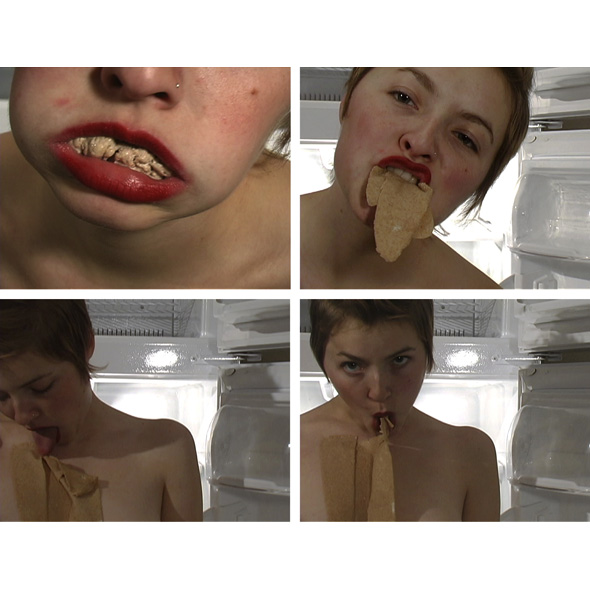Freewaves turned 20 this year. The grassroots new media organization that began in 1989 with a gaping, loosely defined mission to show Los Angeles to itself celebrated its birthday on June 26 with Video on the Loose, a one-night festival at the Los Angeles County Museum of Art (LACMA). In the wide-open plaza that links the museum’s newly built Resnick Pavilion and Broad complex to the older Ahmanson Building, 21 monitors each displayed a video from Freewaves’ double-decade archive. They made up a surprisingly compact circle and Freewaves founder and director Anne Bray originally imagined that viewers would look over the tops of the monitors and into the faces of people watching on the circle’s opposite side. But tall monitor stands prohibited this sort of voyeuristic camaraderie. Instead, to hear over the dint of the DJ and surrounding videos, viewers gathered close to the speakers and tight circles formed around screens. This close proximity added a subtle sense of peer-pressure to the evening’s experience. You didn’t want to be the first to leave your circle, especially if others were intent.
The first time I watched Meena Nanji’s Voices of the Morning, a hauntingly rhythmic black and white film narrated by a young Muslim woman learning how to have a self, I stood beside a tall man with graying golden-blond hair. His intentness worked on me like a weight; even though the faster-moving imagery on the subsequent screen tempted me, I stayed put, acting just as focused as him (and by the video’s end, I really wasn’t acting; I returned to Voices of the Morning two more times that evening).
Social dynamics like these are, in part, what Freewaves is all about.
Two years ago, Freewaves hosted a festival on Hollywood Boulevard. Called Hollywould, it was a feat of bureaucratic juggling that required the cooperation of vendors, shop owners and civic powers-that-be. But hosting a festival in a tourist-heavy thoroughfare meant non-art viewers would at least co-exist with video art. “Someone would be looking at the sunglasses [on a store rack] and someone else would be watching the video and both were intent,” recalls Anne Bray when I meet her for coffee a week after Video on the Loose. Sometimes, the person who came with art-viewing in mind would get waylaid by sunglasses, while the person who came for sunglasses would become engrossed in the art.
When Bray moved to L.A. in the early ‘80s, she found a city with no public art and no public. That wasn’t okay with her. “I was a grad student at UCLA,” she says. “I thought, I’m going to pump art into their homes. They’re going to see it between their toes.” She had hoped to do this via television—which she’s tried over the years with varying degrees of success—but the web has proven a more inviting and malleable medium. Before Bray founded Freewaves, she worked as the video coordinator at Los Angeles Contemporary Exhibitions (LACE) and video became the Freewaves’s signature medium, even though the medium was never the point. “Freewaves was trying to get all these people in the city negotiating each other.”
It has tried this in a variety of ways. Bray, a small staff (which currently includes Assistant Director Heidi Zeller, who interviewed Bray for the Video on the Loose catalog) and her board arranged Internet workshops when the web was still young; they’ve organized video screenings of all sorts in all sorts of public places; and they’ve recently received funding for their upcoming “bus project.” GPS-sensitive video art will stream in L.A. Metro’s public buses, so that, as a bus moves, the video programming will move too, acquainting riders with the neighborhoods they pass through.
“The new identity politics is of place,” says Bray. It’s an idea she’s been thinking about a lot lately and, as she’s talked with others artist and academics, she’s found she’s not the only one. “It’s that we’ve worked on race and gender for so long that people’s interest has shifted. We’re not done, of course. But what about this group of people right here, at this café in Echo Park?” This group certainly fits a niche. Laptops abound; there are a few dogs. Most of us are white and, to be here in the middle of a Monday, must have unconventional day jobs. “People stay with people who are like themselves,” Bray continues. But moving outside those cliques and exploring how one community relates to other communities is how a city “grows up.” “L.A. is becoming a teenager. It’s not really responsible yet but it’s thinking about issues of responsibility.”
In Brooke Alfaro‘s Nueve, a two-channel video installation that streamed during Video on the Loose, two rival gangs from San Felipe, Panama, appear in two separate, paired projections. The gangs look as though they approach each other, meet, and then dance together. Outside of Alfaro’s work, however, they’ve never met peaceably. Nueve nicely stands-in for how Freewaves wants to function: bringing together forces that oppose each other, showing people what they didn’t know they didn’t see. “I want people to face their shit,” says Bray, “but I want it to be an interesting process, one that replaces fear with understanding.”
